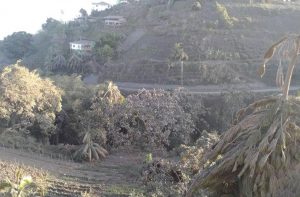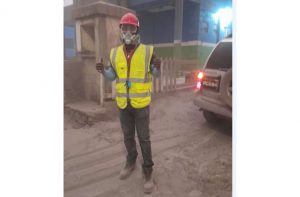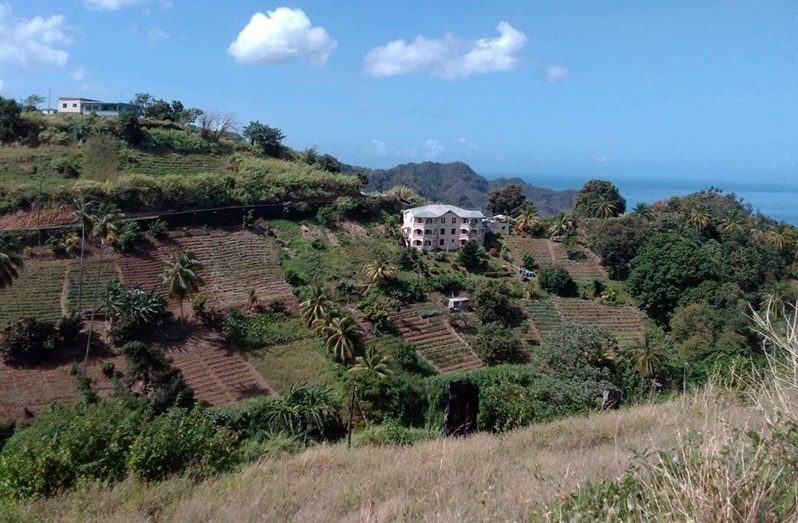— says Guyanese farmers facing volcano, living in ‘orange’ zone; not leaving animals behind
LIVING through a volcanic eruption is not an experience many people have or would want to have, but it is a reality for citizens of St. Vincent and the Grenadines (SVG), who have been facing constant eruptions of the La Soufrière volcano since April 9.
Before now, the last time La Soufrière erupted was in 1979. Guyanese living in St. Vincent, Joylyn Dennis Lampkin, reasoned that not many people who experienced that eruption are still around. She certainly did not experience that. But, contending with this year’s eruptions have, nevertheless, been an experience for her.
She and her husband live in the “orange” zone on the island, which is the second highest hazard zone, given its proximity to the active volcano. Here, the couple manages a substantial acreage of farmlands and rear livestock, which has allowed them to be self-sufficient. And, the couple opted not to evacuate to the “green” or low hazard zones, after La Soufrière began erupting.

“Because of the love of our animals, we didn’t move,” Lampkin told the Guyana Chronicle in a recent interview. “We asked for systems to be put in place to move the animals but no response and eventually, other farmers had to move.”
Though about 90 per cent of the population in the orange zone evacuated, the Lampkins and a few other farmers stayed behind to tend to their animals instead of leaving them to fend for themselves.
“It is sad to see the animals just roaming about and they are dying. This is people’s livelihood… they don’t have anything else and (the animals) don’t have grass to eat,” Lampkin emphasised.

This orange zone, though relatively close to the volcano, is a hilly place. Lampkin explained that she lives at one of the higher points of the island, nearby to the Belmont Observatory which is manned 24 hours by staff of the UWI Seismic Research Centre, who are monitoring the volcano.
“We are not alone, we are surrounded by a network of people — mostly farmers — we support each other and we supply water to other people,” Lampkin explained.
Explaining the situation, Lampkin noted that the local authorities cut the water supply to this area in a bid to encourage people in this area to evacuate to safety. Due to the Lampkins’ proximity to the observatory, however, they were able to benefit from an uninterrupted supply of water that is supplied to the researchers there. And in turn, the Lampkins have been able to supply water to the farmers who remained there but have been without water.
‘NOT FIRE AND BRIMSTONE’
Though she, her husband and dozens of farmers decided to stay behind and take care of their livestock, Lampkin assured this newspaper that she is safe and sound, and well taken care of.
“This kinda thing that I anticipated would get us to move — the heat and fire and brimstone, we’re not getting that kind of impact,” Lampkin posited, adding: “People think we are in danger (but) it’s nothing like that. It’s just the ash… ash is falling down on you all the time but if you are indoors, you can protect yourself.”
The abundance of ash fall has been a bugbear, forcing the Lampkins to constantly clean their premises and even wear special breathing masks at times. Still, Lampkin emphasised that she and her husband prefer to stay in their own homes where they have food, water and constant electricity due to their solar power system.
“It’s not that bad for us here. Those in the ‘red’ zone [the high hazard area, closest to the volcano], they had to leave but those of us on the heights, we don’t really have to leave,” the woman said too.
This abundance of ash fall was highlighted by another Guyanese living on the island, Clifton Pollard. He lives in Belair, in the “green” or low hazard zone which is located at the southern end of the island.
“Green zone is supposed to have light impact, but because this eruption was so big, the green zone wasn’t really looking like a green zone,” Pollard said.
On April 9, when the volcano erupted, Pollard noted that he did not realise that the volcano erupted. In fact, he was only informed of the eruption after he saw the news and checked social media. Subsequently, however, he peered outside and saw a thick, black smoke — that appeared to be a nuclear explosion — spreading across the sky.
SEEMED LIKE A MOVIE
“It seemed like a movie because you only see these things in a movie,” Pollard highlighted.
As the explosions continued, Pollard was part of a team tasked with ensuring communication equipment in the Red zone was well-maintained and not damaged by the volcanic eruption, so that there would be no communication interruption.
Pollard highlighted that the experience was fascinating, not scary. “The only severe things that were happening were stones falling from the sky and a heavy ash fall,” he said, adding: “Imagine it was 10:30 in the morning and the place is just dark. It’s like an old time black and white film, or a grey vintage look.”
The ash eventually covered buildings and surfaces across the island. It spread to the island of Barbados and went across the continent of Africa, with some substances getting as far as India. On SVG, the depth of the ash fall varied.
With the ash fall, thick dust is omnipresent, Pollard related, adding that this can cause severe discomfort and respiratory constraints. It is for this reason, he said, citizens were advised to stay indoors and keep their windows closed. Initially, this was difficult, since intermittent power outages meant that the place was heated. With the eventual return of regular power, however, this situation was remedied.
Meanwhile, all across the green zone, Pollard said that shelters have been set up to host evacuated people. Nowadays, however, Pollard said that there is some semblance of normalcy within the green zone, even as the eruptions continue. But, the people wait with bated breaths since it is unknown what other disaster may befall.
News 784, in St. Vincent and the Grenadines, reported that Geologist and Professor, Richard Robertson, who is stationed at the Belmont Observatory, noted that the eruptions could last for weeks, if not months.












